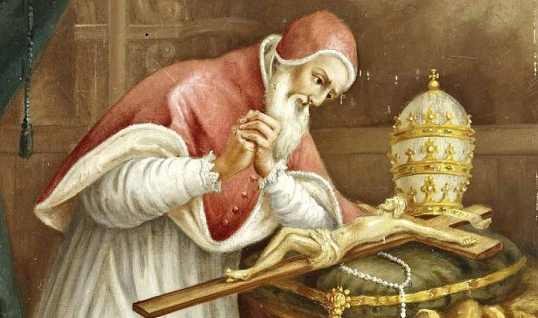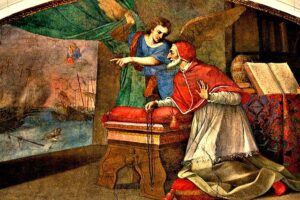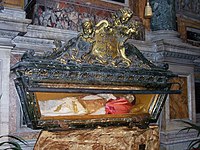
Pope St. Pius V was a priest in religious life who became pope during one of the most tumultuous and critical periods in Church history. Antonio Ghislieri was born in 1504 at Bosco, near Alessandria, Italy. When he was fourteen, he joined the Dominican order and took the name Michele (Michael). He was ordained a priest in 1528 and was assigned to teach philosophy and theology at a Dominican school at Pavia.
DEFENDING THE CATHOLIC FAITH
During these years, Protestantism was on the rise in Britain and central Europe. Alarmed at the damage that was being done to the Church and to souls, Father Ghislieri wrote dozens of essays in defense of papal primacy. In 1544, he was assigned as novice master and was elected prior at several Dominican houses. As prior, he saw the need for a return to monastic virtues and discipline. He lived a penitential life, spoke little, and traveled only on foot. He spent much time in prayer, especially at night. He was summoned to Rome in 1550 and was assigned to the commissariat of the Holy Office, a role related to the legal work of the Church in trying cases of heresy against the Faith.
BISHOP AND INQUISITOR
In 1556, Father Ghislieri was appointed as bishop of Sutri, north of Rome. In 1557, he was appointed inquisitor general of Milan and Lombardy, a position akin to a chief judge. Also, that year, he was elevated to be a cardinal and inquisitor general of the entire Church. In 1559, Pope Pius IV was elected, and he appointed Bishop Ghislieri Bishop of Mondovi in the Piedmont region. During his time there, Ghislieri worked diligently to restore the physical and emotional damage caused by years of warfare in the area. In 1565, he made enemies by opposing Pius IV’s unwise decision to make a thirteen-year-old member of the Medici family a cardinal. He was punished by having some of his authority as inquisitor general removed. Before he had completed his journey to Mondovi, Pius IV, who has not been canonized, died.
ELECTION TO PAPACY: THE REFORMS BEGIN
In January of 1566, Bishop Ghislieri was elected pope, and chose the name Pius V. Undeniably, there was a great need for reform in the Church in the sixteenth century, and the situation became an emergency with the surge of Protestantism beginning in the 1520’s. The Council of Trent was called to address these serious issues, beginning in 1545. Among other things, it called for clear reforms for corruption within the clergy, clarified long-standing Catholic teaching, and repudiated ill-informed attacks directed at the Church from Protestants. The Council concluded in 1563, and the job of organizing and implementing the needed reforms fell to Pius V. He embraced this great task promptly after assuming his office. He simplified the functioning of the papal court, doing away with absurd luxuries. He had a new comprehensive Catechism of the Catholic Church published, providing a concise guide to Church teaching. He wrote a reformed breviary, so that all clergy and religious would have a reliable format for praying the Divine Office each day. Most notably, Pius V made a standard Roman Missal in 1570, which was to be used throughout the Latin (non Eastern-rite) Church. This set of rubrics for celebrating the Mass remained in place until the radical changes implemented in 1970 during the papacy of Paul VI. Also in 1570, Pius excommunicated Queen Elizabeth I of England, daughter of Kind Henry VIII. This decree came in response to her declaring herself the supreme head of the Church in England, and it excused her subjects from being forced to acquiesce to her. He designated St. Thomas Aquinas a Doctor of the Church and had his writings republished, Aquinas being the only person other than Jesus and Mary who is named in canon law.
THE LEPANTO POPE

In addition to defending Christendom from Protestant aggression coming from the north, he also had to deal with a deadly Mohammedan foe to the east – the Ottoman Empire. Originating in Turkey, this force was making vast conquests into Europe. To combat this, Pius formed the Holy League, working to draw Christian monarchs together to fight this incursion. A key figure was Don Juan of Austria, who was admiral of a vastly outnumbered fleet of ships during the Battle of Lepanto, which prevented the Ottoman’s capture of Vienna. Before this 1571 battle, Pius called upon the faithful to pray the Rosary, asking the Blessed Virgin’s help in defending Christendom. After this victory, he instituted a feast day to be kept each October 7, Our Lady of Victory, in thanksgiving for her assistance. He also had a miraculous vision of this victory as it happened, though he was in Rome, far away from the battle. Pius is closely associated with the Dominican Rosary, for it was he who published a guide of how to pray it, including the second half of the Hail Mary. In accordance with the instructions The Mother of God gave to St. Dominic, Pius set the fifteen mysteries which the faithful were to meditate upon while reciting the prayers. He was known to be very tough against such mortal sins as sodomy, adultery, and especially blasphemy. This made him the subject of much criticism, despite the fact that such firmness against heinous sins was consistent with Scripture and Tradition, dating back to St. Paul’s Epistles. He died at Rome May 1, 1572 at age sixty-eight and is entombed at the Basilica of St. Mary Major in Rome.

Pope St. Pius V accomplished an enormous amount of good despite his papacy only lasting six years. The Church needed a strong and committed reformer and that is what she got in Pius V. Often overlooked is his lifetime of charity. In keeping with his Dominican formation, he lived an ascetic life. He personally visited sick people in hospitals, and during a time of famine in Rome, he brought in shipments of grains from other parts of Europe at his own expense, which he distributed to the poor. His care for the poor contributed to a noticeable change in Roman culture. Pius was canonized in 1712, the last pope to be canonized until Pope Pius X was in 1954. Among his patronages are Malta, his hometown of Bosco Marenga, and popes named Pius. Since 1969, his feast day, a memorial, has been celebrated on April 30.
